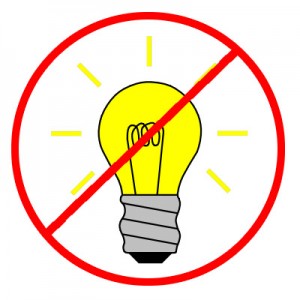Say Goodbye To Incandescent Light Bulbs – Buy In Bulk Now!
You Better Hurry Up and Buy Lots of 100W Incandescent Light Bulbs
 I’m going to try my best to keep my politics in check with this post. However, if you haven’t paying attention you might be shocked to find out that when the ball falls in Time Square on January 1, 2012, it will be illegal to manufacture 100 watt incandescent light bulbs in the United States. So if you love 100 watt incandescent light bulbs (I love them in certain applications) you better run out and buy up a huge stock!!!
I’m going to try my best to keep my politics in check with this post. However, if you haven’t paying attention you might be shocked to find out that when the ball falls in Time Square on January 1, 2012, it will be illegal to manufacture 100 watt incandescent light bulbs in the United States. So if you love 100 watt incandescent light bulbs (I love them in certain applications) you better run out and buy up a huge stock!!!
Energy Independence and Security Act of 2007
According to the Energy Independence and Security Act of 2007, 100-watt general service incandescent light bulbs can not be manufactured for use in the United States as of January 1, 2012. Starting January 1, 2013 75 watt incandescent light bulbs will meet the same fate. Lastly, 60 and 40 watt bulbs will be phased out starting January 1, 2014.
Ultimately this means the end to one of the most used widely used and relied upon consumer products in over 100 years. The change will certainly cause lots of confusion, frustration and years to work out all the repercussions.
Incandescent Light Bulb Alternatives
The result of this new law will leave consumers with two basic options for lighting. CFL’s (Compact Fluorescent Lights) and LED (Light Emitting Diodes) are the two most promising alternatives to replace the tried and true bulbs of the past.
I’m not a fan at all of CFL’s. I hate the color of the light and get extremely frustrated with their poor performance in cold weather. The only up side to CFL’s are their cost compared to LED’s and availability.
On the flip side I’ve become quite impressed with the new LED’s on the market. I recently converted halogen lights to LED’s in my home with great success. The color of the LED’s is almost exactly the same as the incandescents and the performance is much greater than CFL’s. They do have some minor issues with electronic interference with dimmers and other accessories. However those are small issues compared to the performance.
Light Bulb Black Market?
Time will tell if the phasing out of incandescent bulbs will create a black market of bulbs. I’m sure that the Internet will be full places to try and purchase these bulbs. It seems crazy that we’ll no longer be able to buy these bulbs but that’s the hard reality of the hyper environmental ecosystem that exists in today’s society.
Will you continue using incandescent bulbs? Will you try to buy a huge stock and keep them around for years to come?













Would definitely love to try LEDs as I have exactly the same issues with CFLs and their light colour.
The humble light bulb has always fallen victim to political moves. Their longevity for example never really improved, we never saw substantial innovations there.
I am pinning my hopes on LEDs.
We have a number of rooms on dimmers as a way to 1.) reduce energy consumption and 2.) soften up the lighting. I don’t really want to change up all of those to cfl dimmers. Also, being in a northern climate I can’t rely on cfl for my exterior applications. Energy costs have already prompted people to make changes that work for them, the government didn’t need to step in.
Any idea on 3-way bulbs? I haven’t heard anything on those.
I just can’t stand CFL’s so I try to avoid them at all costs. Good question on 3-way bulbs, I haven’t seen any but I wasn’t really looking. I’m VERY impressed with the light on my latest LED’s, but they are WAY too expensive at the moment.
No need to worry! We now have another year before we begin to see the effects of the Energy Independence and Security Act of 2007 on our light bulbs…but there is another option for lighting our homes. Although we all have been lighting our world with 100 year old technology (yes, light bulbs have changed little in 100 years) in the 21st century, it will not be going anywhere. Phillips Lighting has developed light bulbs (Halogena Energy Savers available at Home Depot) that conform with this law while still giving us the lighting we love. Check it out…
http://www.nytimes.com/2009/07/06/business/energy-environment/06bulbs.html?